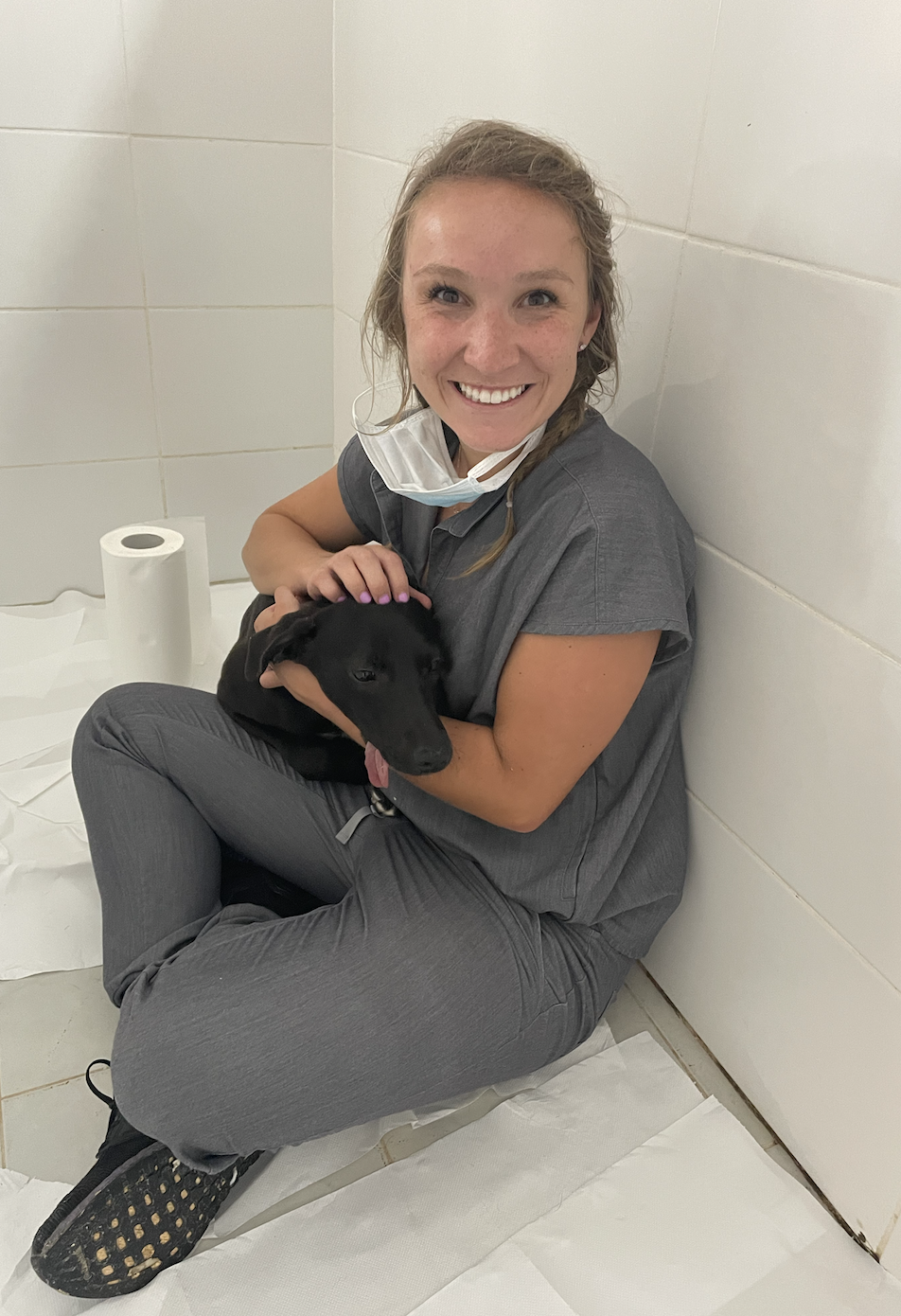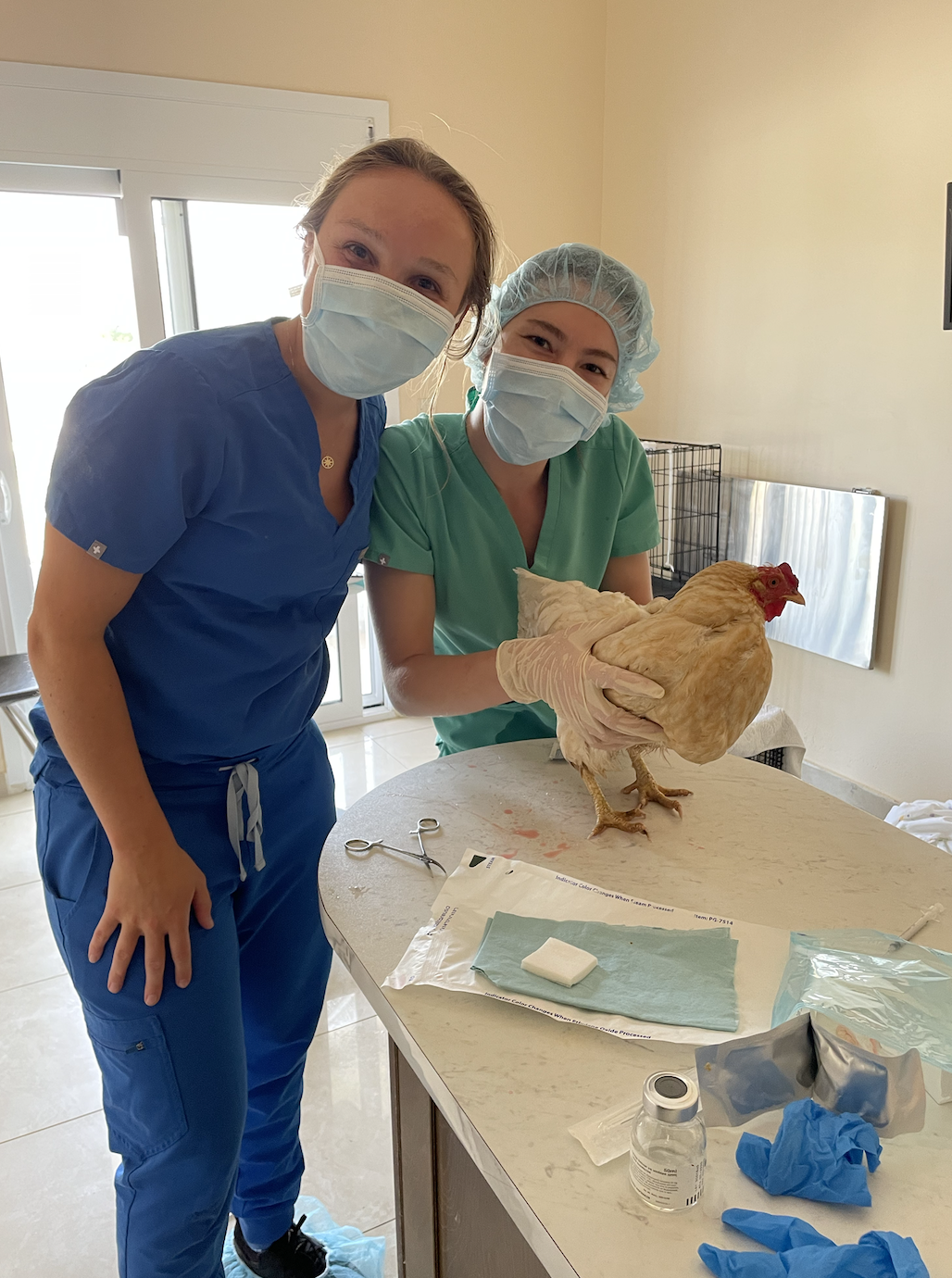STUDENT EXPERIENCE: GREECE
 Monday, August 21, 2023 at 12:00PM
Monday, August 21, 2023 at 12:00PM Submitted by Valentina Poggi, University of Illinois (via IVEC)
 "My name is Valentina Poggi and I am a fourth year student at the University of Illinois College of Veterinary Medicine. I am honored to have been chosen for an International Veterinary Experience Scholarship and would love to share with you my phenomenal experience learning veterinary medicine abroad. This past month I had the unique opportunity to attend an international externship in Rhodes, Greece for two weeks. This experience was primarily focused on shelter medicine. During the first week, I spent a majority of my time in the clinic under the supervision of Board Certified Small Animal Soft Tissue Surgeon, Dr. Clara Moran and a Board Certified Shelter Veterinarian, Dr. Loukia Agapis. My team and I were able to spay and neuter nearly 60 feral cats that were brought to us through the local capture and release program our first week in Greece. In addition to fine tuning my surgical skills I also had the opportunity to learn about the miller’s knot and I was also able to incorporate it into my routine spay procedures. In addition to the feral feline spays and neuters, I was also able to see and help with a lip commissure to eyelid transposition for repair of a feline eyelid agenesis, a canine cystotomy, a kitten evisceration repair, a chicken cloacal prolapse, and even a brachiocephalic obstructive airway surgery. The variety of surgeries I was able to witness and help with on this international experience was incredible. In addition to improving my surgical technique, I also had the opportunity to help with a suspect parvo case. This experience increased my confidence in my skills and also allowed me an opportunity to grow as a doctor. Working as the primary surgeon or clinician on my own cases allowed me to put my knowledge to the test and really allowed me to expand my knowledge. It also reminded me that asking for help and advice is something I should be prepared to do as a future practitioner. Additionally, I was forced to learn not only how to practice veterinary medicine in a different country with different expectations, language barriers, cultural customs, and different supplies. Learning about the supply constraints in Greece and working with financial constraints associated with shelter medicine was something I had not been exposed to yet. From this experience I was able to witness firsthand how the feral feline population is constantly growing in Greece. Being in Greece and helping with the capture and release program allowed me to be able to make a small dent in helping with population control and hence the welfare of these animals.
"My name is Valentina Poggi and I am a fourth year student at the University of Illinois College of Veterinary Medicine. I am honored to have been chosen for an International Veterinary Experience Scholarship and would love to share with you my phenomenal experience learning veterinary medicine abroad. This past month I had the unique opportunity to attend an international externship in Rhodes, Greece for two weeks. This experience was primarily focused on shelter medicine. During the first week, I spent a majority of my time in the clinic under the supervision of Board Certified Small Animal Soft Tissue Surgeon, Dr. Clara Moran and a Board Certified Shelter Veterinarian, Dr. Loukia Agapis. My team and I were able to spay and neuter nearly 60 feral cats that were brought to us through the local capture and release program our first week in Greece. In addition to fine tuning my surgical skills I also had the opportunity to learn about the miller’s knot and I was also able to incorporate it into my routine spay procedures. In addition to the feral feline spays and neuters, I was also able to see and help with a lip commissure to eyelid transposition for repair of a feline eyelid agenesis, a canine cystotomy, a kitten evisceration repair, a chicken cloacal prolapse, and even a brachiocephalic obstructive airway surgery. The variety of surgeries I was able to witness and help with on this international experience was incredible. In addition to improving my surgical technique, I also had the opportunity to help with a suspect parvo case. This experience increased my confidence in my skills and also allowed me an opportunity to grow as a doctor. Working as the primary surgeon or clinician on my own cases allowed me to put my knowledge to the test and really allowed me to expand my knowledge. It also reminded me that asking for help and advice is something I should be prepared to do as a future practitioner. Additionally, I was forced to learn not only how to practice veterinary medicine in a different country with different expectations, language barriers, cultural customs, and different supplies. Learning about the supply constraints in Greece and working with financial constraints associated with shelter medicine was something I had not been exposed to yet. From this experience I was able to witness firsthand how the feral feline population is constantly growing in Greece. Being in Greece and helping with the capture and release program allowed me to be able to make a small dent in helping with population control and hence the welfare of these animals.
 The second week of my externship I spent at the Rhodes Animal Welfare Municipal Shelter. Greece in addition to having a large stray feline population the country also has a large stay dog population. To give you an idea of the extent, the shelter I visited was originally created to house 70 dogs but currently the shelter has nearly 300 dogs. This shelter is attempting to accommodate as many dogs as they possibly can to help alleviate any potential animal suffering. At the shelter I was able to learn from a board certified shelter veterinarian, Dr. Loukia Agapis, the importance of shelter rounds and how to appropriately screen both the dogs and their environment both effectively and efficiently. As veterinarians we take an oath – “Being admitted to the profession of veterinary medicine, I solemnly swear to use my scientific knowledge and skills for the benefit of society through the protection of animal health and welfare, the prevention and relief of animal suffering, the conservation of animal resources, the promotion of public health, and the advancement of medical knowledge. I will practice my profession conscientiously, with dignity, and in keeping with the principles of veterinary medical ethics. I accept as a lifelong obligation the continual improvement of my professional knowledge and competence.” This international experience reminded me of the oath I will shortly be taking this coming May. It reminded me that regardless of what country we as veterinarians practice in we all must live this oath. During shelter rounds, I was able to assess the animal health and welfare of nearly every kennel in the shelter. In addition to the animal health and welfare I assessed things like the cleanliness, drainage, as well as the safety of the animal’s enclosure. Thinking in this mindset reminded me the importance of assessing more than just the physical health of an animal. I also was able to practice my ability to triage patients in order to determine what order we should see each patient during our week at the shelter. Having this experience opened my eyes that there is more than one way to practice veterinary medicine and reminded me how important giving back to the local community is."
The second week of my externship I spent at the Rhodes Animal Welfare Municipal Shelter. Greece in addition to having a large stray feline population the country also has a large stay dog population. To give you an idea of the extent, the shelter I visited was originally created to house 70 dogs but currently the shelter has nearly 300 dogs. This shelter is attempting to accommodate as many dogs as they possibly can to help alleviate any potential animal suffering. At the shelter I was able to learn from a board certified shelter veterinarian, Dr. Loukia Agapis, the importance of shelter rounds and how to appropriately screen both the dogs and their environment both effectively and efficiently. As veterinarians we take an oath – “Being admitted to the profession of veterinary medicine, I solemnly swear to use my scientific knowledge and skills for the benefit of society through the protection of animal health and welfare, the prevention and relief of animal suffering, the conservation of animal resources, the promotion of public health, and the advancement of medical knowledge. I will practice my profession conscientiously, with dignity, and in keeping with the principles of veterinary medical ethics. I accept as a lifelong obligation the continual improvement of my professional knowledge and competence.” This international experience reminded me of the oath I will shortly be taking this coming May. It reminded me that regardless of what country we as veterinarians practice in we all must live this oath. During shelter rounds, I was able to assess the animal health and welfare of nearly every kennel in the shelter. In addition to the animal health and welfare I assessed things like the cleanliness, drainage, as well as the safety of the animal’s enclosure. Thinking in this mindset reminded me the importance of assessing more than just the physical health of an animal. I also was able to practice my ability to triage patients in order to determine what order we should see each patient during our week at the shelter. Having this experience opened my eyes that there is more than one way to practice veterinary medicine and reminded me how important giving back to the local community is."
 IVEC,
IVEC,  International,
International,  experiences in
experiences in  Experiences
Experiences 


